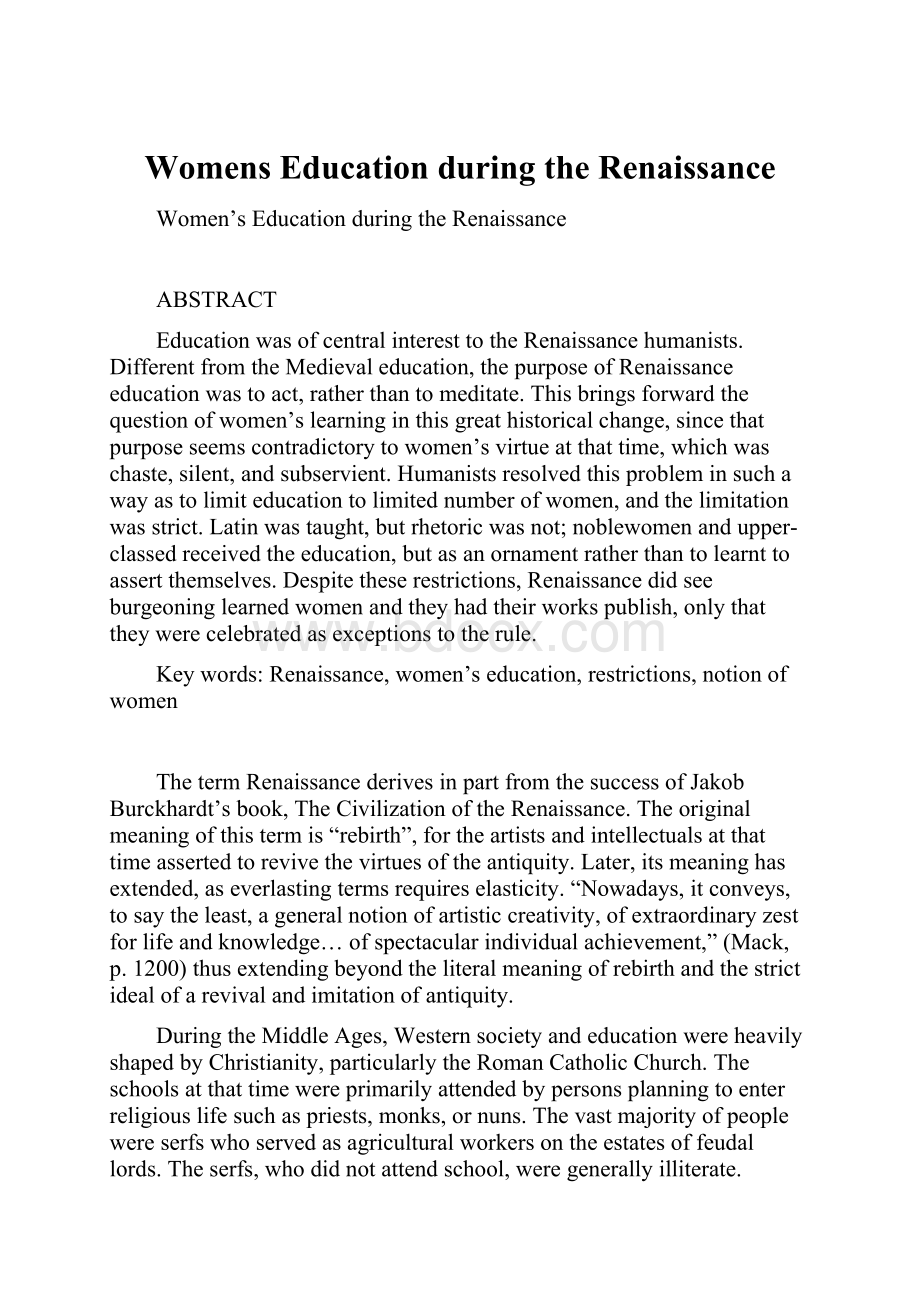Womens Education during the RenaissanceWord格式文档下载.docx
《Womens Education during the RenaissanceWord格式文档下载.docx》由会员分享,可在线阅读,更多相关《Womens Education during the RenaissanceWord格式文档下载.docx(13页珍藏版)》请在冰豆网上搜索。

ABSTRACT
EducationwasofcentralinteresttotheRenaissancehumanists.DifferentfromtheMedievaleducation,thepurposeofRenaissanceeducationwastoact,ratherthantomeditate.Thisbringsforwardthequestionofwomen’slearninginthisgreathistoricalchange,sincethatpurposeseemscontradictorytowomen’svirtueatthattime,whichwaschaste,silent,andsubservient.Humanistsresolvedthisprobleminsuchawayastolimiteducationtolimitednumberofwomen,andthelimitationwasstrict.Latinwastaught,butrhetoricwasnot;
noblewomenandupper-classedreceivedtheeducation,butasanornamentratherthantolearnttoassertthemselves.Despitetheserestrictions,Renaissancedidseeburgeoninglearnedwomenandtheyhadtheirworkspublish,onlythattheywerecelebratedasexceptionstotherule.
Keywords:
Renaissance,women’seducation,restrictions,notionofwomen
ThetermRenaissancederivesinpartfromthesuccessofJakobBurckhardt’sbook,TheCivilizationoftheRenaissance.Theoriginalmeaningofthistermis“rebirth”,fortheartistsandintellectualsatthattimeassertedtorevivethevirtuesoftheantiquity.Later,itsmeaninghasextended,aseverlastingtermsrequireselasticity.“Nowadays,itconveys,tosaytheleast,ageneralnotionofartisticcreativity,ofextraordinaryzestforlifeandknowledge…ofspectacularindividualachievement,”(Mack,p.1200)thusextendingbeyondtheliteralmeaningofrebirthandthestrictidealofarevivalandimitationofantiquity.
DuringtheMiddleAges,WesternsocietyandeducationwereheavilyshapedbyChristianity,particularlytheRomanCatholicChurch.Theschoolsatthattimewereprimarilyattendedbypersonsplanningtoenterreligiouslifesuchaspriests,monks,ornuns.Thevastmajorityofpeoplewereserfswhoservedasagriculturalworkersontheestatesoffeudallords.Theserfs,whodidnotattendschool,weregenerallyilliterate.
VariouswerethereasonswhypeoplebegantoactivelypursueknowledgeduringtheRenaissance.Economicallyspeaking,theburgeoningbourgeoisieclassdemandedasayinthepoliticalfield.Sohugewastheobstacleofbeingilliteratethattheyfounditnecessarytobeeducated.Besides,thegradualdeclineofreligiousinfluencealsocatalyzedthedemand.ThecorruptionsofthechurchmensetpeopletofindrealinterpretationandunderstandingoftheBiblebytheirown.Moreover,theinventionoftheprintingpressinthemid-15thcenturymadebooksmorewidelyavailableandincreasedliteracyrates.Thetechnologicaldevelopment,aswellasthisyearningforknowledgeandindividualachievementprosperedtheinstitutionofeducation.
Thissocialdevelopmentissodelightingandoverwhelmingthatmostpeopleholdthebeliefthatmen’scultivationismankind’scultivation;
however,someothersdoubtthemeaningofRenaissanceforwomen.JohnKelly,inherarticle“DidWomenHaveaRenaissance”,pungentlypointedout“yetpreciselythesedevelopmentsaffectedwomenadversely,somuchsothattherewasnorenaissanceforwomen-atleast,duringtheRenaissance.”(Kelly,p.19)KellynotedthatcomparedwithwomenintheMedieval,duringtheRenaissance,noblewomen,wereincreasinglyremovedfrompublicconcerns---economic,political,andcultural-althoughtheydidnotdisappearintoaprivaterealmoffamilyanddomesticconcernsasfullyastheirsistersinthepatricianbourgeoisie.Hence,theirlossofpublicpowermadeitfeltinnewconstraintsplacedupontheirpersonalaswellastheirsociallives
Thispaperdoesnotgosofarastoquestiontheacceptedschemeofhistoricalperiodization.Inotherwords,itrecognizestheexistenceofRenaissance,forbothmenandwomen.Thepurposehereistotakewomen’seducationduringtheRenaissanceasastartingpoint,andtoinvestigateinto“thewidelyheldnotionoftheequalityofRenaissancewomenwithmen.”(Kelly,p.20)First,aholisticviewwillbetakenabouttheRenaissancewomen’seducation,withcomparisonwiththeMedieval.Thesecondfocusonthewomen’seducationduringtheRenaissance,mainlydealingwithsuchquestionsaswhatweretaught,andtheintendedpurposeofthiseducation.Inthispart,wewillhaveacloserviewofRenaissance,bystudyingDesideriusErasmus,arenownedRenaissancescholar’sthoughtsandworks.“ThereisagreementamongscholarsthatthisdifferenceinmomentandapproachtotheeducationofboysandgirlscanbeexplainedinlightofErasmus(andbyextensionthehumanists)viewsonthepurposeofeducation.”(Rummel,pp.8-9)AsErasmusproducedworksthatareesteemedasliterarycanon,suchasThePraiseofFolly,women’simagewillbeexaminedinthesecanons,toglimpseatthequestionthatwhetherthesearecanonsforwomen.Thelastpartconcernstheproductoftheeducation,thatis,thelearnedwomen.Wewillhaveatrytoprobethelifeofsomewomenwriters-or,tobemorespecific,ofthosewomenwhoseworkshavesurvived–duringtheRenaissance.
DuringtheMedievalperiod,aspointedoutearlier,educationwasreligiouslyoriented.Whilethemajorityofthepeoplewereilliterate,fewerwomenthanmenreceivededucationandtheywerenuns.Thechurchprovidedsomelimitedopportunitiesfortheeducationofwomeninreligiouscommunitiesorconvents.Conventshadlibrariesandschoolstohelppreparenunstofollowthereligiousrulesoftheircommunities.
Besidesthenunswhowereeducated,therewereanothergroupofwomenintheMiddleAgeswhocouldaffordeducation,thenoblewomen.Itwasnotararitythatyoungnoblewomenwereabletoreadandwrite.InLexSaxonum,alawintheeighthcentury,itillustratedwhatwomenwereallowedtoinherit:
PsalmsoftheBibleandotherreadingsfacilitatingwomentogotothechurch.(Bumke,p.424)
AstheMiddleAgesprogressedintotheRenaissance,women’seducationchanged.Ifmorewomenwereabletobeeducated,theproportionofeducatedwomendeclined.AstheMiddleAgesandtheRenaissancecovereddifferentperiodsoftimeoverawiderangeofcountries,itisdifficulttoconcludeademographicchangefromtheMiddleAgestotheRenaissance.WhatisdefiniteistheBlackDeathalmostendedtheMiddleAgesandendednearlyhalfoftheEuropeanpopulation.TheensuingRenaissanceprobablysawanincreaseinpopulation,althoughhowlargetheincreasewasremainsquestion.Anyway,onefeaturetodifferentiatetheRenaissancefromtheMedievaltimesisthegrowingsecularcultureandthedecliningofChristianity.(Xu,p.169)Thisunavoidablyaffectedthenuns’education,thenumberofwhichdecreased.
Thisinfluencemightaffectlessonnoblewomen,buttheeducationofthemandtherisingbourgeoisiewomenwasnobetterforotherreasons.Takewomenofthemiddleclassforexample.ScholarWilliamMontershows,inhisessay“ProtestantWives,CatholicSaints,andtheDevil’shandmaid:
WomenintheAgeoftheReformations,”howtheseextremelyclassicalideas(fromtheclassicalwritingsoftheancientGreeksandRomans)aboutwomenwhencombinedwiththeReligiousReformationincreasedthevalueofwomeninthedomesticrealmandsawtheirroleasmothersandwivesbecomeextremelyimportant,almosttotheexclusionofanyotherroles.(Monter,pp.203-219)Theexclusionpartlyresultedfromthedeprivationofeducationontheonehand,andontheother,worsenedthedeprivation.Itwasbecausemoreoccupationsrequiredacertainorevenuniversityeducation,towhichmostwomenweredeniedaccess.Forthosejobsthatdidnotrequirespecificeducation,menbegantodefinetheirjobs,astheprovincesofmenonly.Asthenumberofavailablejobsforwomendecreased,eventuallymorewomenbegancompetingforfewerjobs,usuallydomesticinnature,effectivelykeepingtheirwageslow.Eventuallyworkassociatedwithwomenandthedomesticarenabecamedevaluedinandofitselfinrelationtomen’swork.Thelessimportantwomenwereinpeople’seyes,thelessnecessitypeoplesawinwomen’seducation.
Womenlostmorerights,orgainedfewerrights,asthehistoricalfaceofEuropechangedfromtheMedievaltotheRenaissance.Although,theproportionofeducatedwomendecreased,hopefullyandprobablythebulkofeducatedwomenincreasedwiththebiggerpopulation.
Thewomen’seducationduringtheRenaissanceseemsdismaying,statisticallyorproportionatelyspeaking;
however,moreinformationisneededtounderstandtherealsituationofit.Arethecontentsofwomen’seducationthesameinthecourseoftime?
Advocatesofwomen’srightsinboththenineteenthandthetwentiethcenturiesmadeequalaccessforwomentoeducationalinstitutionsoneoftheirkeydemands.OnlyThrougheducation,theyargued,couldwomenbecomeknowledgeablecitizensorentercareersinwhichtheywouldbeeconomicallyindependent;
theyregardededucationasinseparablefrompoliticalandeconomicrights.TheRenaissanceperiodalsosawnumerouscallsfortheimprovementofwomen’seducation,butthelinesofargumentwereverydifferent.“Learning,bytheadvocatesofwomen’seducation,meanttraininginclassicallanguages,philosophy,thesciences,theology,andhistory,wasprimarilyforawoman’sindividualfulfillmentortomakeherabetterChristian;
itwasnotlinkedwithpoliticalorvocationalaims.”(Wiesner,pp117-118)
ThroughouttheMiddleAges,thesubjectofeducationforwomen,wasahotlydebatedissue.Aseducationwasdirectlyconnectedwiththechurchitwasinevitablethatthechurch'
sviewsofwomenshouldhaveledpredominated.St.ThomasofAquinas,1225-1274,whowasperhapsoneofthegreatteachersoftheperioddeclaredwhatwasclearlyawidelysupportednotionregardingwomen:
“Thewomanissubjectt